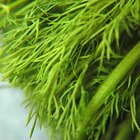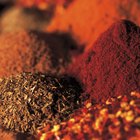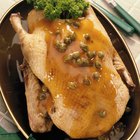Fresh ginger is a distinctively flavored root that lends a sweet and spicy quality to foods. Fresh ginger is usually easy to find in supermarkets year-round and can be stored indefinitely in the freezer, but there are several good substitutes if fresh ginger is unavailable for some reason. Although they may not have the exact flavor of fresh ginger, these substitutes are great stand-ins and also delicious in their own right.
Types
Ginger that has been dried and ground to a powder can be purchased in the spice aisle of any supermarket. Although it does not have the same spiciness that fresh ginger does, the underlying flavor is the same. When replacing fresh ginger with ground ginger in a recipe, adding a tiny pinch of cayenne pepper along with the ground ginger adds the spiciness that is lacking. Fresh ginger is not always a good substitute for ground ginger, due to its liquid content and spiciness. Ground ginger is a necessity in desserts like apple and pumpkin pie.
Types
Also known as blue ginger, galangal is a root from the same family as regular ginger. It looks like a cross between ginger and a white radish or parsnip, but it is much harder than ginger; however, once grated, the texture is quite similar. Galangal is widely used in Thai and Indonesian cuisine. Its flavor is not exactly like that of ginger, but it does have some of the same exotic flair. Using galangal in combination with ground ginger as a fresh ginger substitute yields more ginger-like results.
Types
Ginger that has been cooked and marinated in a sugar syrup is known as preserved ginger. Its flavor is much sweeter and milder than that of fresh ginger, so it is really only appropriate for use in desserts or other sweet dishes. Preserved ginger is used widely in Asian and Middle Eastern cooking. There is also a salted variety of preserved ginger, which can be found primarily at Chinese specialty shops. This type of ginger is both salty and sweet--it can be used as a substitute for regular ginger, but only in dishes where both salt and sweet are desired.
Types
Ginger that has been cooked in a sweet syrup, then coated with sugar and dried is known as crystallized or candied ginger. It does retain some of its natural spicy ginger flavor, but it is extremely sweet and should only be used in desserts or eaten as a candy.
Types
A sushi bar standby, pickled ginger retains fresh ginger's unique spicy flavor. However, the solution used for pickling adds a distinct tang and sweetness that fresh ginger does not have. Pickled ginger can be used as a substitute for fresh ginger in some Asian recipes, but be prepared for that tangy pickled taste to come through, and use it sparingly so that it doesn't overwhelm other flavors.
Related Articles

Galangal Powder Substitute

Baking Substitution for Rosewater

Classic Russian Spices

What Herbs & Spices Flavor Fish?
What Is the Cooking Substitution for ...

Difference Between Peppermint Extract & ...

Can I Exchange Cinnamon for Allspice?

The Disadvantages of Saccharin
Substitutes for Alum in Pickling

What Is a Good Substitute for ...

Substitutions for Cooking With Hot ...

Can I Substitute Vodka for Rum in a ...

What Can You Use to Substitute ...

How to Buy and Use Capers in Cooking
Substitutes for Lemon or Orange Peel

Difference Between Clover & Orange ...
Can You Eat Ginger Peel?

Garam Masala Substitute

Difference Between Gumbo and Etouffee

How to Cook With Lemon Zest & Peel
Writer Bio
Lindsay Woodland is a professional opera singer, semi-professional pastry chef and personal finance enthusiast from Queens, N.Y. She holds a bachelor's and master's degree in music and speaks German and Italian in addition to her native English. Woodland has been a freelance writer and editor since 2008 and writes for multiple websites and blogs.